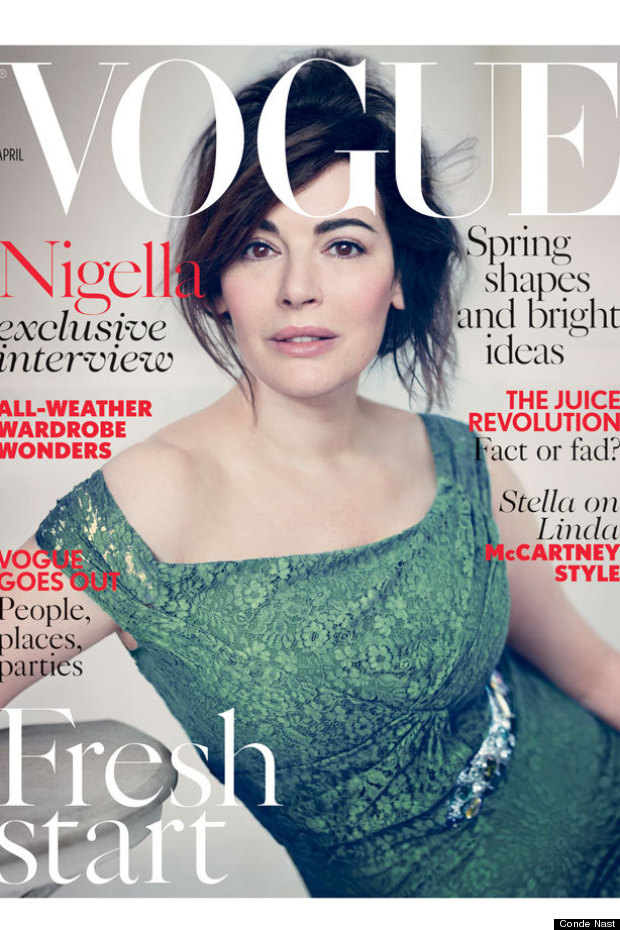Vogue editor Alexandra Shulman told Lily Allen in a Radio 2 interview she doesn't think readers want to see "real" people in the pages of her magazine. As someone who's been subscribing to the publication for nearly 20 years, I have to agree.
Aged 13, I started buying Vogue every month with my rubbish wages from being a greasy spoon's Saturday girl. Something about those covers, those clothes, those headlines promising glamour was just the best thing in the world. I wanted to see a place where people wore Chanel. Where champagne was endless. Where no one talked about fried egg sandwiches.
![vogue nigella]()
That place was Vogue. Kate Moss nonchalantly sitting in a red slip accessorised with a sceptre. Sophie Dahl in a sugar pink dress looking distinctly post-coital. Elizabeth Hurley straddling Elton John as he played the piano. Nothing about it felt real and that was the appeal.
When it came to reality, I had newspapers and a distinctly unglamorous adolescence to contend with - this slab-heavy magazine actually made me aspire for more. "You don't have to wear sale rack New Look forever," it seemed to say. "There's a lot more for the taking..."
Yes, the models were thin and still are but laying that problem at Vogue's door is a bit picking-and-choosing your enemies. Open any newspaper's fashion or lifestyle supplement and you'll find women just as skinny, just as unreal. But because they're packaged up next to features about political and socio-economic issues, that makes it okay? No - it's just easier to point the finger at publications dedicated to fashion.
And you can hardly blame Shulman for saying in the aforementioned interview she's "bored" by questions about skinny models. The problem of how women are portrayed in the media is huge, yet - when it comes to fashion imagery - is repeatedly given to Shulman to solve.
It's been argued if Vogue changed it's approach others would follow, but if you genuinely think that, you need to wake up. You - the reader - decide to a large extent what goes on and in a magazine. Why do you think Jennifer Aniston gets so many covers? Sales.
There's much written about women wanting women they can relate to on the pages of glossy magazines. Yet when Vogue put Adele on its cover in 2012, it was one of the worst sellers in the magazine's history. If something doesn't sell, the message is there's no appetite for it - back to the old formula then.
Personally, the skinny models don't make me feel bad about myself (and, to be clear, that's not because I'm in any way model-esque. Picture the average woman. That's me). Nor do the "real" models make me feel good. When it comes to magazines like Vogue, I want to see something beautiful - something magical. I value the escapism these publications offer and because of that, when Shulman says she doesn't believe readers want to see "real", I think she's got a damn good point.
Aged 13, I started buying Vogue every month with my rubbish wages from being a greasy spoon's Saturday girl. Something about those covers, those clothes, those headlines promising glamour was just the best thing in the world. I wanted to see a place where people wore Chanel. Where champagne was endless. Where no one talked about fried egg sandwiches.

That place was Vogue. Kate Moss nonchalantly sitting in a red slip accessorised with a sceptre. Sophie Dahl in a sugar pink dress looking distinctly post-coital. Elizabeth Hurley straddling Elton John as he played the piano. Nothing about it felt real and that was the appeal.
When it came to reality, I had newspapers and a distinctly unglamorous adolescence to contend with - this slab-heavy magazine actually made me aspire for more. "You don't have to wear sale rack New Look forever," it seemed to say. "There's a lot more for the taking..."
Yes, the models were thin and still are but laying that problem at Vogue's door is a bit picking-and-choosing your enemies. Open any newspaper's fashion or lifestyle supplement and you'll find women just as skinny, just as unreal. But because they're packaged up next to features about political and socio-economic issues, that makes it okay? No - it's just easier to point the finger at publications dedicated to fashion.
And you can hardly blame Shulman for saying in the aforementioned interview she's "bored" by questions about skinny models. The problem of how women are portrayed in the media is huge, yet - when it comes to fashion imagery - is repeatedly given to Shulman to solve.
It's been argued if Vogue changed it's approach others would follow, but if you genuinely think that, you need to wake up. You - the reader - decide to a large extent what goes on and in a magazine. Why do you think Jennifer Aniston gets so many covers? Sales.
There's much written about women wanting women they can relate to on the pages of glossy magazines. Yet when Vogue put Adele on its cover in 2012, it was one of the worst sellers in the magazine's history. If something doesn't sell, the message is there's no appetite for it - back to the old formula then.
Personally, the skinny models don't make me feel bad about myself (and, to be clear, that's not because I'm in any way model-esque. Picture the average woman. That's me). Nor do the "real" models make me feel good. When it comes to magazines like Vogue, I want to see something beautiful - something magical. I value the escapism these publications offer and because of that, when Shulman says she doesn't believe readers want to see "real", I think she's got a damn good point.